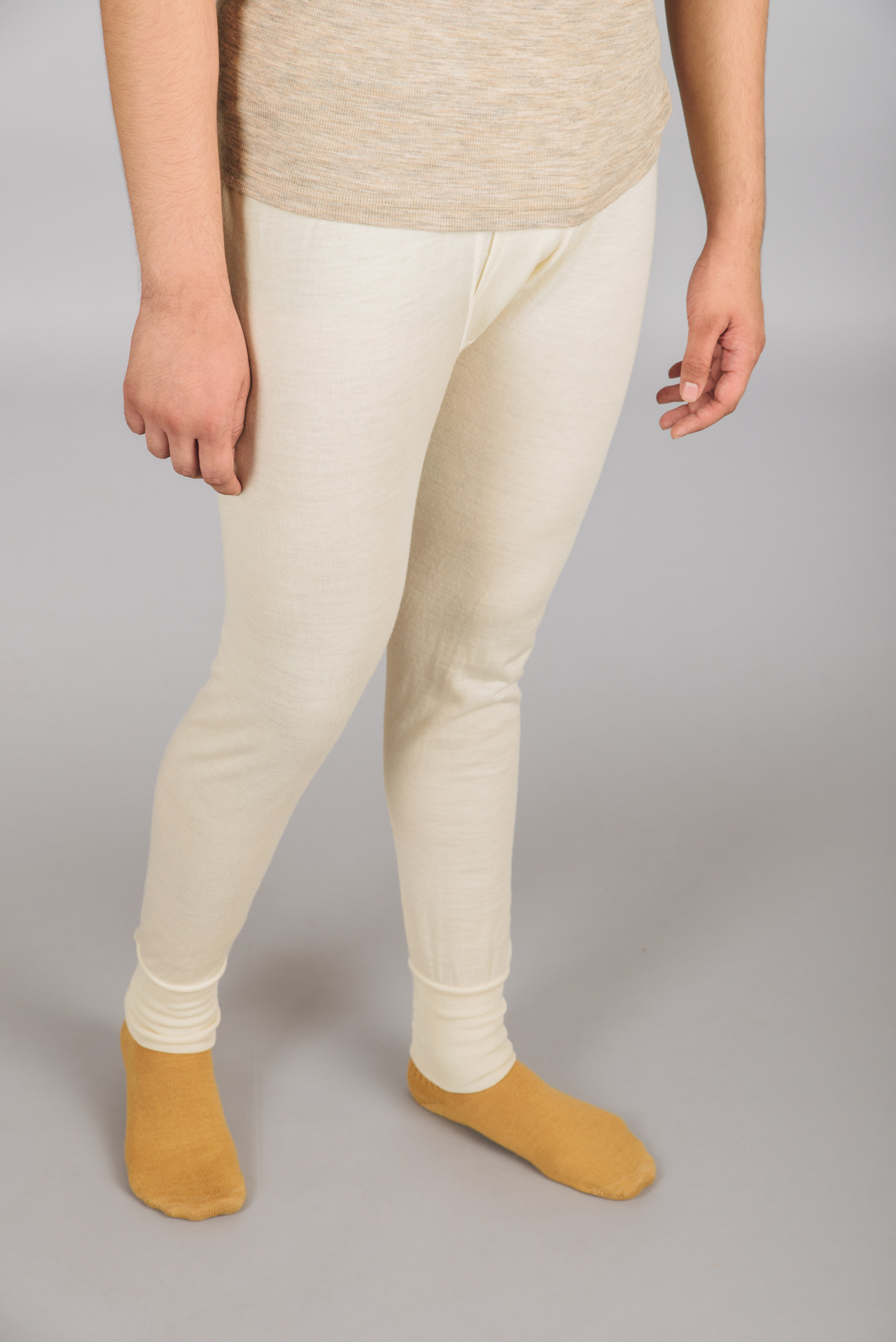Trekking in Himalayas on a frozen river....Sounds like your next challenge?
Chadar Trek, also known as the frozen river trek is among a few unique paths in the world located in the Zanskar region of Ladakh, India. Hiking up this trail along the frozen path of the river Zanskar, you will be thrill-bounded by the landscapes of snow, ice and freezing waters in subzero temperatures while experiencing Zanskar traditions – an offset of Tibetan and Indian cultures.
We bring you a guide to the Chadar Trek along with helpful experiences shared by adventure-seeking individuals who like to push their limits and have been on this very unique trek route.
Breaking away from their everyday professional lives, Manish a category manager at Goibibo, Abishai – a software engineer & certified mountaineer, Yash – Project Manager at Enterprising Enterprise, Yuktie, the Founder of Kosha – winter travel wear and Rohit who owns his own adventure club ‘Canvas n Chrome’ share their insights on all the prep required for the Chadar trek and their journey through the icy path.
Grade of the Trek: Difficult/Challenging
Best Trekking Period: Mid-January to mid-February
A blanket of ice, literally
The Zanskar river, in Ladakh, is completely frozen during the winters transforming the upper surface of the river into a widely spread white blanket (Chadar) of ice. This is the only trekking path in the world where it could vanish beneath your feet!
“The upper layers of the river get frozen to 6ft or more. We walked surfaces which crackled like shards of glass, was shift like fresh snow and at times was super slippery like an ice rink.” – Yuktie
Yash recollects the funny instances when everyone got on the icy trail for the first time and had fallen off on their rear. Rohit has been leading treks on the Chadar trek over 5 years with his adventure company Canvas N Chrome, he describes the initial phase of the trek as a pack of falling cards!
The entire trek requires you to carefully slide every step as versus walking or stomping your feet to avoid weak ice and slippery nodes. Not to worry, within a few kilometres you will slowly master walking on the frozen river or the penguin walk.
How to get there?
Located at a maximum altitude of 11,123ft, when this trek happens, it’s not safe neither possible to come via Leh-Manali Highway; as roads aren’t accessible. So the only option is to get there via a flight. All high passes are closed due to heavy snowfall. The nearest airport is Leh which is the capital city of Ladakh.
Trek Route:
 Leh- Chilling – Tilat Do: The starting point to this trek is Tilat Do. After departing from Leh, in about 3-4 hours of drive, you will reach Chilling. You will trek from this village to the Indus and the Zanskar River’s confluence also known as the Tilad Sumdo.
Leh- Chilling – Tilat Do: The starting point to this trek is Tilat Do. After departing from Leh, in about 3-4 hours of drive, you will reach Chilling. You will trek from this village to the Indus and the Zanskar River’s confluence also known as the Tilad Sumdo.
1st Checkpoint – Shingra Koma: You will reach your 1st checkpoint trekking from Tilat Do to Shingra Koma covering about 10-12 km, this will be your first stretch of the trek on the Chadar. Shingra Koma gets its name from a plant called Shingra, found extensively in this area.
2nd Checkpoint Tibb Cave- Tib Yokma Cave is one of the many caves in the Zanskar Canyon, many passerby villagers and trekkers take rest in these caves. The caves have been the best places for the cooks to prepare instant noodles for their trekkers while on the stopover.
3rd Checkpoint – Nyerak Village & waterfall
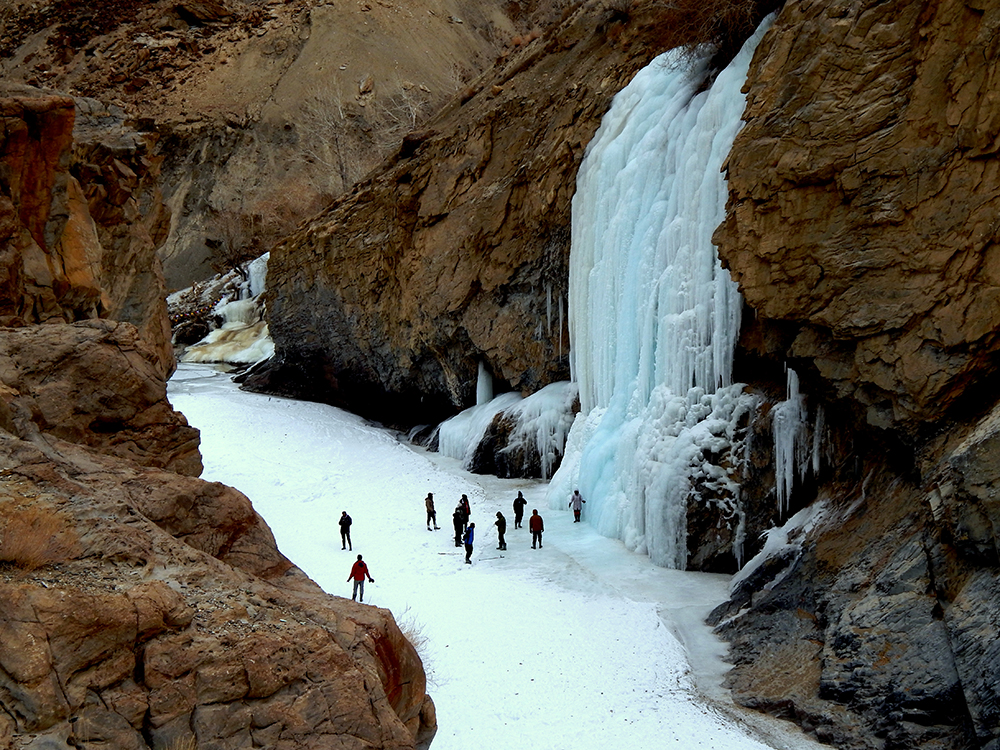 [The Magical Frozen Waterfall en-route the Chadar Trek]
[The Magical Frozen Waterfall en-route the Chadar Trek]
One of the challenges of the Chadar is the ever-changing snow sheet. While Manish made it up to Nyerak, due to the changing river frozen paths and obstacles they had to return.
While trekking from Tibb to Nyerak(which is the last point of the trek for most people, the one with the giant 50 feet frozen waterfall), we faced a large melted part of the river which was impossible to cross. It was almost half a km long & the cliffs along were also very difficult to climb.
With Nyerak village being the last pit-stop of the trek, you will follow back the same route to Tilat Do on the river and head back to Leh. If one wants to brave covering the entire trek length of the Chadar Lake, it will take 15 days to and back from the end-point Padum.
History of the trek:
Rohit shared with us that the Chadar is the only connection that the people from Zanskar have with Leh in Winter as the road route via Kargil (Pensi La) shuts down due to the accumulation of snow.
“…the only way to their home is through this river path and there exists no roadways or alternative routes till date. Walking on the frozen river is the only way to get there. This trail was very popular then among foreign trekkers and has now been taken up by numerous Indian adventure companies.”
Preparation for the Trek:
The total trekking length of the Chadar by the time you return is around 105 km. On average you will walk 12-16 km or 6-7 hours a day and this will require a certain degree of physical and mental preparation beforehand. Here are a few fitness regimes you should adopt before the trek:
Fitness regime:
Ideally, two and half months of duration for a fitness regime will be good enough to handle the extremely cold weather conditions and high altitudes.
Yuktie began training 3 months in advance which involved a mix of cardio and weight training with each workout lasting for 60-90 minutes, 6 times a week.
- If not two-months at least a month before the trek, begin with a daily routine of 30-40 minutes walk slowly converting it into a jog after 15-20days.
- Do basic workouts that will increase your stamina and build good agility to walk long hours on a stretch on ice sheets.
- Try bathing with cold water which will also increase your resistance power.
Walking with a backpack:
Carrying a backpack while you exercise helps the practice of trekking with winter gear. Starting with 2kgs, gradually increase the weight to 6kgs.
Abishai resorted to the tried and tested method of walking with a weighted rucksack. He carried his load himself while on the Chadar Trek which was a part of his preparation for the Everest Base Camp trek two months later.
Though Yash had not done any physical preparation before the trek, he feels one has to be mentally strong more than the physical exhaustion to keep going strong.
“It is the cold that gets you during the trek. One needs to be mentally strong and thoroughly follow the advice given by the trek leader…the more you will be prepared before the trek, the better you will be mentally during the trek.”
It is worthwhile listening to the trek leader and make sure to bring all the food, medical supplies, and gear (jackets, shoes, bags) as advised by the trek leaders who will prepare you a few months before the trek.
Acclimatization:
Consider arriving at Leh at least 2 days before the scheduled trek to acclimatize to the cold weather and while spending two days at higher altitudes, one can explore monasteries of Thikse, Phyang, Namgyal Tsemo, Stok coveted in rich Tibetan cultures.
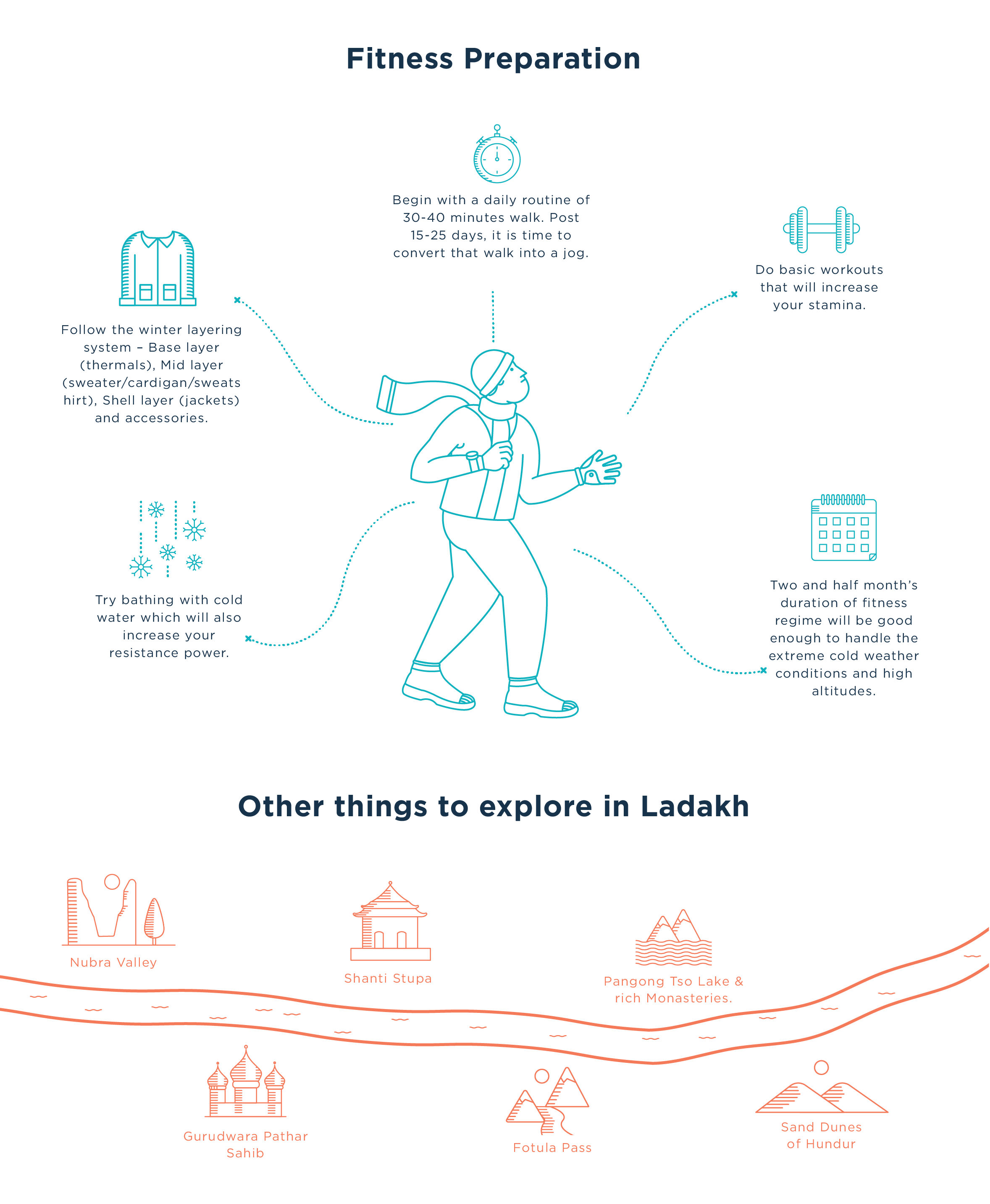
Other places to explore in Ladakh:
Gurudwara Pathar Sahib, Nubra Valley, Shanti Stupa, Fotula Pass, Sand Dunes of Hundur, Pangong Tso Lake.
As for Manish the biggest preparation for Chadar is to prepare oneself against the extreme cold.
“It is an easy trek with little or no gradient… Dress up in layers, keep all parts of the body covered & make sure you are properly acclimatized in Leh before starting the trek.”
Essential Clothing for Chadar Trek:
Prepare your clothing gear working from the base layers – mid-layer to outerwear. Benefits of layering – will help you maintain adequate temperatures without overheating or freezing especially on the Chadar trek where the temperatures suddenly drop down as low as -20° C or even as low as -30 ° C with sunny bursts in the noon. Here is what you will require to system layering your outfit for the trek:
Base Layer: Carry at least two sets of thermal wear (thermal top and bottoms).
For all your base layer needs Kosha Thermal wear comes in variants of woollen and cotton, as well as tops with full length, half, and sleeveless to suit your winter sport.
For Chadar trek, opt for full sleeves woollen top and pant for optimum warmth. Cotton clothing for the trek as a base layer is not at all recommended as it will soak up moisture from your body leaving you feeling cold.
Mid Layer: A good mid-layer will trap heat that escapes from the base layer while wicking out moisture. Kosha fleece jackets, woollen sweaters, and hoodies are popular mid-layers that can also be worn during mild winter temperatures.
Outerwear: This outwear will protect you from harsh winds and the freezing spills of the icy river. It’s waterproof, breathable and other functional features will help you achieve ease in movement while trekking.  Kosha Hardshell waterproof jacket comes with ventilation zippers in armpits to breeze out during intense hiking. The hardshell pants are perfect, as it has gaiters on the hem that will protect you from freezing waters or snow entering your feet.
Kosha Hardshell waterproof jacket comes with ventilation zippers in armpits to breeze out during intense hiking. The hardshell pants are perfect, as it has gaiters on the hem that will protect you from freezing waters or snow entering your feet.
Types of Shoes:
Gumboots will be the ideal choice for this trek. Double up your feet with two pairs of Kosha’s Technical socks if wearing gumboots for an extra layer of warmth against snow or freezing waters.
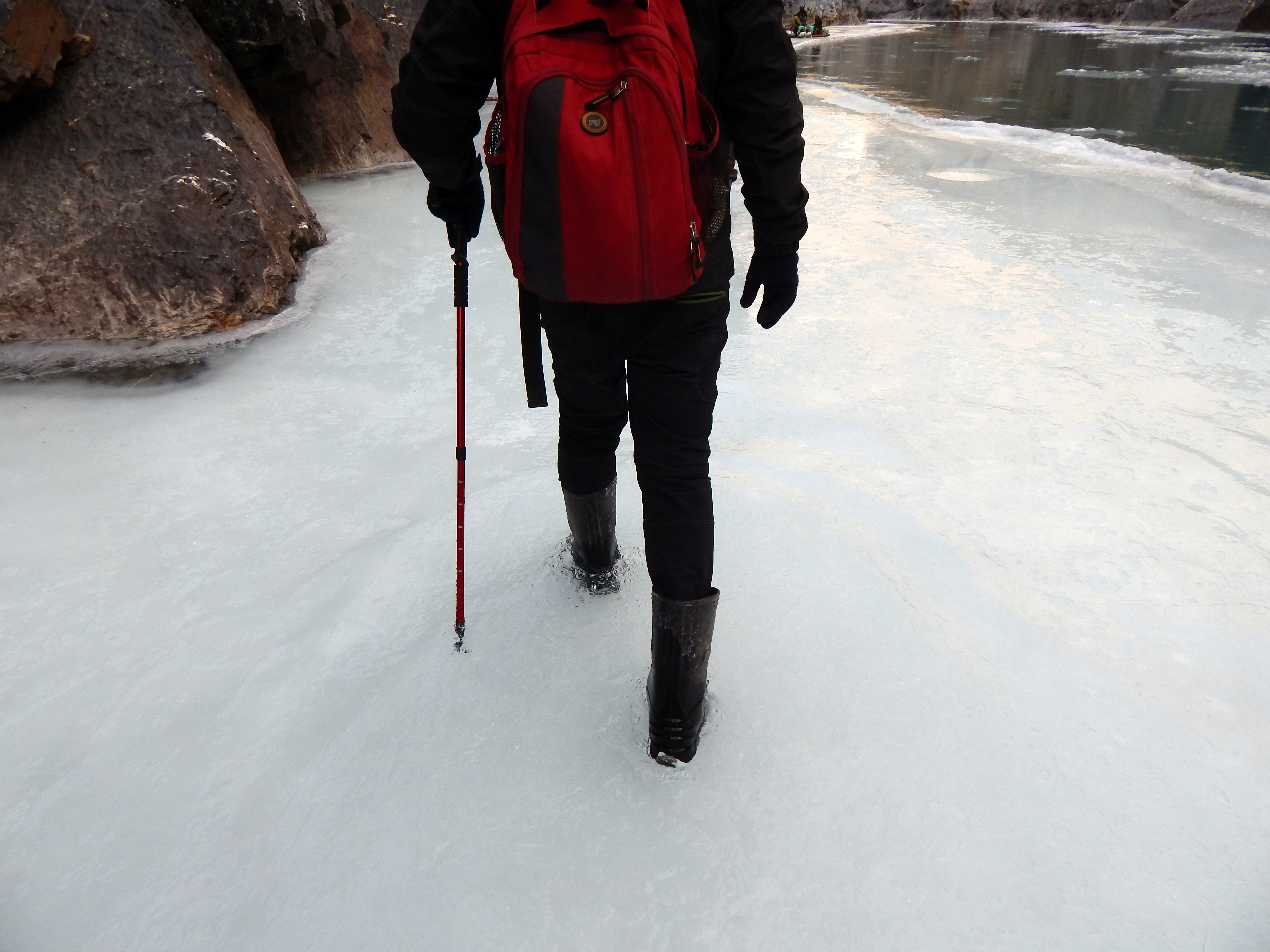 [Gumboots are your best option to walk on the frozen river]
[Gumboots are your best option to walk on the frozen river]
Gumboots are a must
Manish confesses his biggest lesson learned from the Chadar trek is underestimating the need for a pair of gumboots.
“I did not carry a spare pair of Gumboots for Chadar with the thought that my mountaineering shoes will be good enough. While my shoes were very good for traction & bearing cold; on the first day, we faced a melting portion of the river & had to wade in the water, resulting in wet shoes. While it was a challenge to walk in wet shoes, constantly keeping the toes in motion to avoid frostbite, the shoes never became dry during the trek. While everyone got ready in the morning, I had to sit in front of the fire with my shoes in hands, trying to melt the hardened overnight snow so that I can wear them. Had to do this activity till the end of the trek. Lesson – Always carry a pair of Gumboots; they dry easily & help you wade through water to an extent.”
Prevent frostbites by keeping your feet dry and replacing your socks at the end of each day. Ideally, with every 6-7 hours of walking, change your socks to avoid moist feet.
Travel Hack:
You can dry out your damp socks by the bonfire in the evenings!
Other Essentials:
Yash’s must-have other things list:
Headgear
UV sunglasses
Fleece gloves
Waterproof padded gloves
Headlamp
For monkey caps, waterproof gloves or fleece buffs Accessories by Kosha have been designed for the best warmth and dry performance.
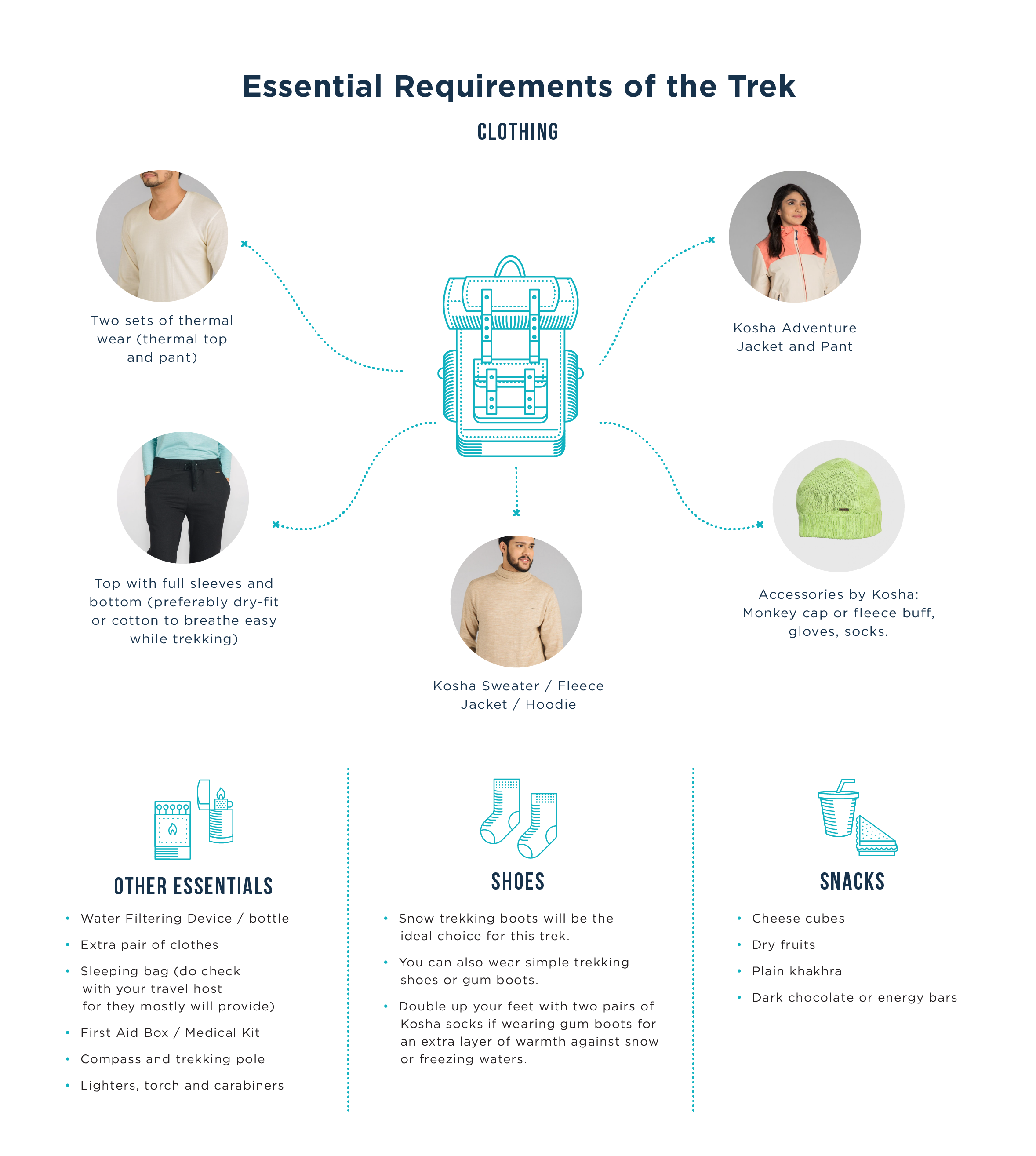
Snack Hack:
While the cooks will have you covered with warm soupy noodles, Maggi and tea at breaks, carry snacky items along such as cheese and dry fruits to keep your body boosted with warmth and energy. Carry these nibbles in the small seal-able pouches to avoid moisture in your food items.
The Experience:
Right from the time you head to Tilat Do on to the Chadar and back, you will witness amazing landscapes running through beautiful Ladakhi roads.
“The first steps on Chadar. Before you do it, it is an enigma, something you have no idea about. Those first few unsure steps on Chadar are amazing. Everyone is very excited & you can see the happiness all around you. And this continues for the next 6 days” – Manish
 [View of Gorge and Zanskar River]
[View of Gorge and Zanskar River]
“Before the trek, I questioned what could be exciting in walking along this Gorge. I was humbled to see the landscape change with every turn, from frozen waterfalls to unbelievable bridges connecting two mountains” – Yuktie
“Every year, the Chadar trek has given us a dynamic experience …the ultimate goal for us, is to trek through the Zanskar, reach the Nyerak village to witness the frozen waterfall, a magnanimous gigantic water structure and to click photos of it; touching it is the most wow moment!” – Rohit
“Getting hot black tea and biscuit at every check point to reaching Nyerak and getting to sleep in a house made of mud and bricks with a make shift heater were among a few of the memorable experiences” – Abishai
“All of us adults had become children and were sliding like penguins, sea lions on the icy Chadar” – Yash
Challenges:
Over the years, Rohit has witnessed increasing popularity for the trek owning to social media, photographs, and a fad among youngsters who tend to opt for this trek regardless of their interests, knowledge, or experience. There are four main challenges one should not dismiss as Rohit vows to remind trekkers, again and again, to be fully prepared for the following 4 challenges.
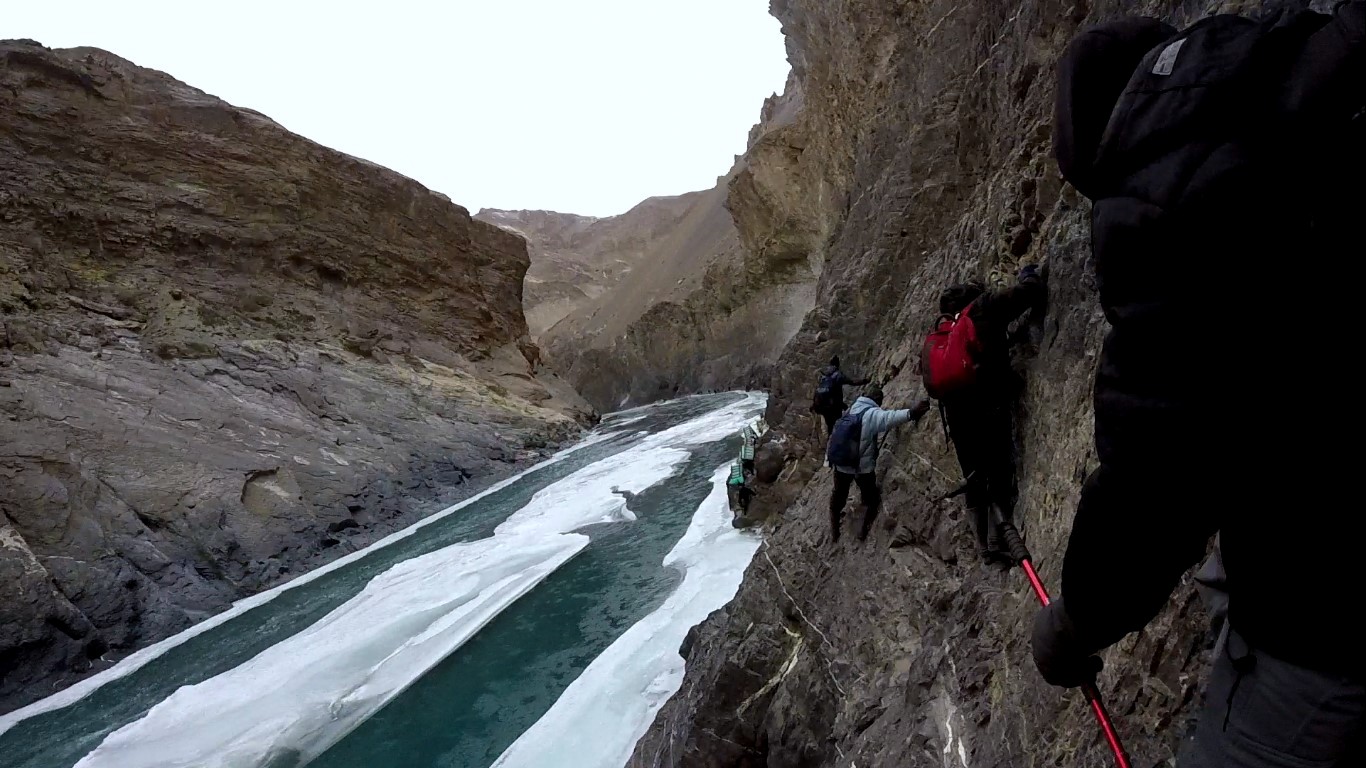 [In certain parts, where the river is not frozen,
[In certain parts, where the river is not frozen,
trekkers have to go from one end to the other crossing the rocks]
1) Higher altitude with a maximum of 11,123ft.
Acclimatization is important before you begin the trek. Anyone with serious health conditions should not attempt.
2) Freezing sub-zero temperatures hitting as low as -35° to -40° C.
Do not compromise on your gear. Good and functional gear is very important.
“…my friends and I shared the tent with Rohit (Canvas n Chrome). Everyone kept grumbling about how cold it was at night despite having proper clothing and good sleeping bags.
We then agreed on using the old technique of conserving body heat and hence packed everyone, alternate head to feet sleeping style in one single tent for the rest 6 nights; this also meant once you are in your sleeping bag you stay in there till morning breaks.” – Abishai
3) This is not a regular trek
Walking on the slippery ice requires you to slide and walk, any clumsy moments can land you flat on the ice, and in any instance of an injury, one has to walk back or continue ahead as he/she cannot be stationed on the river.
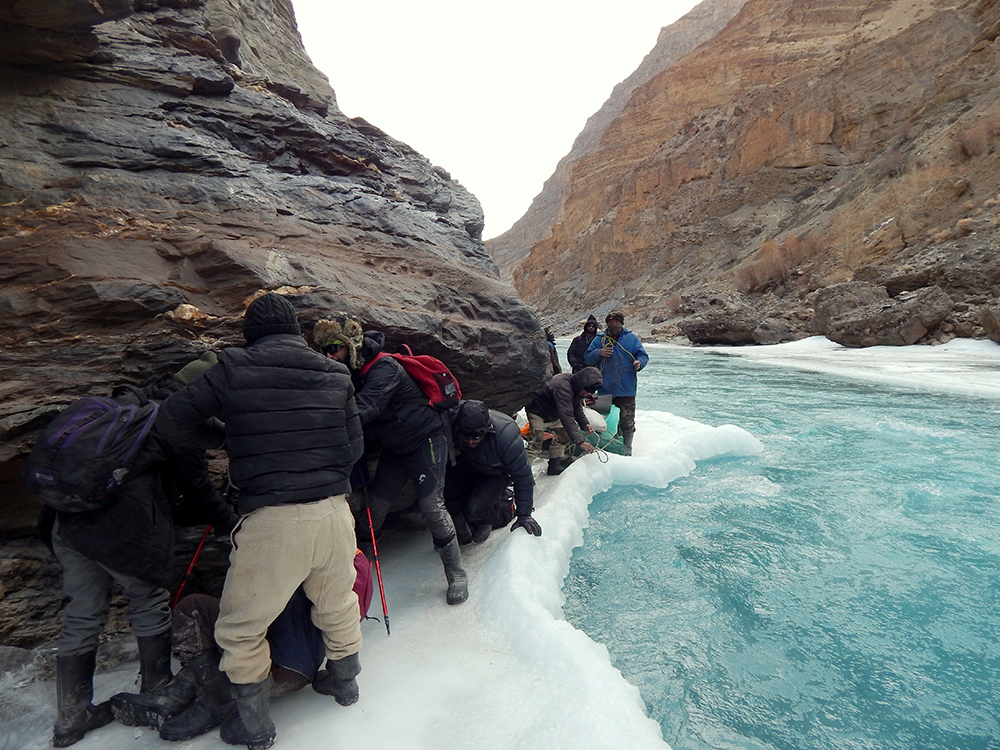 [Walking cautiously, on the ice formed on the edges of the river]
[Walking cautiously, on the ice formed on the edges of the river]
4) Loss of foothold
No other regular trek has a loss of foothold like the Chadar trek’s icy trail. Often it is hilarious to see people fall like a pack of cards or walk like a penguin, it is funny till no one gets hurt.
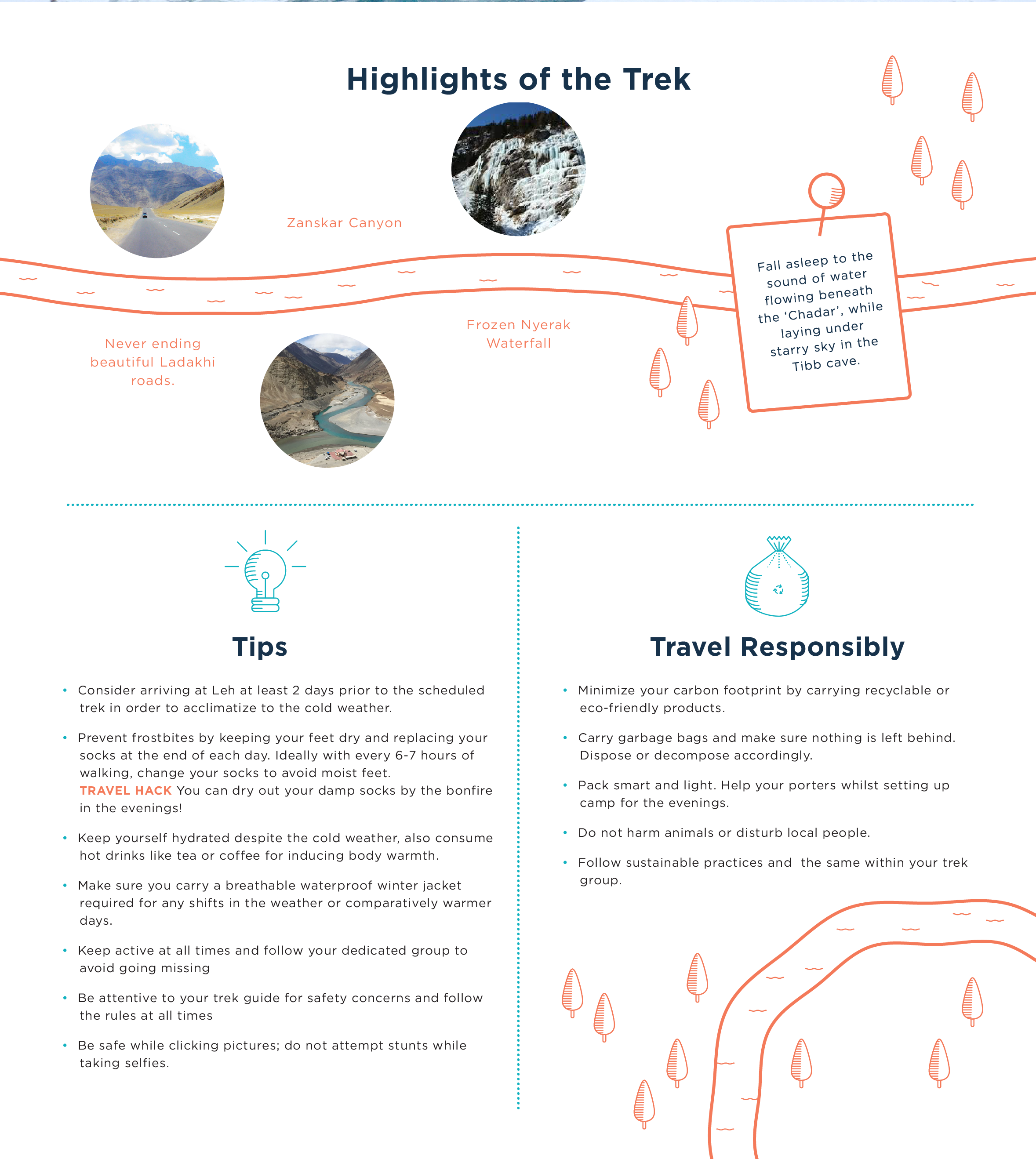
Tips for a safe trek:
- Keep active at all times and follow your dedicated group to avoid going missing
- Be attentive to your trek guide for safety concerns and follow the rules at all times
- Be safe while clicking pictures; do not attempt stunts while taking selfies
- Choose the right trek operator
At the heart of your trek experience will be the right trekking company.
“Be very cautious in selecting with whom you are going. If things are not right during the Chadar trek, the cold will get you and you will feel like quitting in the middle of the trek.” says Yash.
Select a tour company with experienced trek leaders and the group size does not exceed more than 10 or 15 at most. With many stringent policies, yet many tour operators combine multiple permits and have over 18-20 members at a time on the trek, says Rohit.
Regardless of the numerous deals on the Chadar Trek, be sure of selecting the right experienced partner for this trek to avoid bad situations while trekking in the cold.
Abishai highly recommends, “Chadar should not be undertaken as the first high altitude trek, there are too many variables where things can go wrong and injuries by falling as well. We heard of a foreigner who had fractured her ankle at Nyeraks and required helicopter rescue. The terrain is not difficult and the cold is manageable with gear; the issue is the accessibility. First-time altitude treks must be done in places where the access to medical help if needed is simple and easy.”
Having said all of that, all the rules and preparations for the Chadar Trek cannot be translated to the real experience. Yuktie has already conquered the Chadar trail, but on her bucket list is to walk the entire length of the Chadar River from Chilling to Zangla and explore the villages of Zanskar.
With the winters ascending in the valley, will you dare to go on the Chadar Trek?
Picture Courtesy: Yash Doshi.
